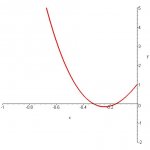?
(Ummm, equations do not have roots; equations have solutions, functions have zeros, and polynomials have roots.)
Yup, the Rational Root Theorem shows us that the root you're looking for is irrational; Joel's suggestion for approximating it is an easy way to go.
Yet, I'm thinking that finding an approximation for just one zero of the first derivative is not sufficient to show that the given equation has only two Real solutions.
It's possible for a 6th-degree polynomial to have two or three local minima located below the x-axis. In this case, the polynomial has four or six Real roots, not two.
In other words, to show that function f has only two Real zeros, we also need to demonstrate that it has only one minimum.
This can be done, using the second derivative. (In fact, I suspect that you could probably use the third derivative to prove that the second derivative is positive for all x, since the third derivative is probably a straightforward cubic.)
Also, the entire exercise can be completed without resorting to any graphs at all, if you understand the basic shapes of polynomials and the relationships between signs of derivatives and increasing/decreasing status of functions.
In other words,
analysis !
This is relatively heavy stuff to digest, for beginning students; so, if your course allows things like graphing technology or software as tools, I'd sure use them.

If you don't understand what I wrote about eliminating the possibility of four Real solutions, let me know. I'll draw some pictures, and, if it turns out that I actually know what I'm talking about, I'll upload them, too!
MY EDIT: included possibility of six roots, before someone points it out to me
